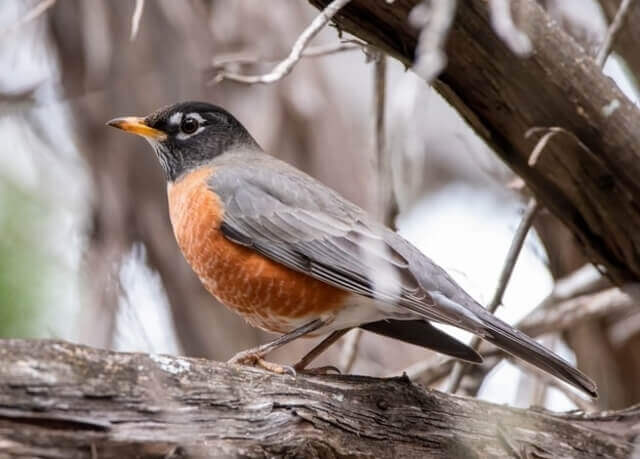Japanese beetles are invasive garden pests that can cause significant damage to plants and crops. Fortunately, there are several bird species that prey on these beetles, offering a natural form of pest control.
In this blog post, we’ll explore some of the birds that eat Japanese beetles, complete with photos of each species. But first, let’s take a closer look at these pesky beetles and the damage they can cause.
Table of Contents
- 1 What are Japanese Beetles?
- 2 Where are Japanese Beetles Found?
- 3 How to Control Japanese Beetles?
- 4 Birds That Eat Japanese Beetles
- 4.1 Common Grackle
- 4.2 Common Starling
- 4.3 Northern Cardinal
- 4.4 Western Meadowlark
- 4.5 Eastern Meadowlark
- 4.6 Gray Catbird
- 4.7 House Sparrow
- 4.8 Wood Thrush
- 4.9 Brown Thrasher
- 4.10 Red-headed Woodpecker
- 4.11 Blue Jay
- 4.12 Eastern Kingbird
- 4.13 Scarlet Tanager
- 4.14 Northern Mockingbird
- 4.15 American Robin
- 4.16 Ring-necked Pheasant
- 5 Frequently Asked Questions
- 6 Conclusion
- 7 Author
What are Japanese Beetles?
Japanese beetles are small, metallic-green insects that are native to Japan. They were accidentally introduced to the United States in the early 1900s, and have since become a common garden pest throughout North America.
These beetles are known for their voracious appetite, feeding on the leaves, flowers, and fruits of a wide range of plants and crops. The damage caused by Japanese beetles can be severe, especially when populations are high.
They can defoliate entire trees and shrubs, leaving them vulnerable to disease and other pests. Additionally, the beetles release pheromones that attract even more beetles to the area, exacerbating the problem. To make matters worse, Japanese beetles are difficult to control.
Many traditional insecticides are ineffective, and they can harm beneficial insects and birds that help control other garden pests. However, by attracting and supporting bird populations in your garden, you can help naturally reduce Japanese beetle populations and protect your plants.
Where are Japanese Beetles Found?
Japanese beetles are most commonly found in the eastern and central regions of North America. They prefer warm, humid climates and can thrive in a variety of habitats, including gardens, lawns, and agricultural fields.
Japanese beetles are attracted to a wide range of plant species, but they have a particular preference for roses, grapevines, and fruit trees. They also feed on a variety of ornamental plants, including linden trees, hibiscus, and hydrangeas.
If you’re unsure whether Japanese beetles are present in your area, keep an eye out for their telltale damage. The beetles typically skeletonize leaves, meaning that they eat the tissue between the veins, leaving only a lacy framework.
They may also feed on flowers and fruit, causing them to wither and drop prematurely. Once you’ve identified Japanese beetle damage, there are several steps you can take to reduce their impact.
This may include removing damaged plant material, using physical barriers such as netting or row covers, or employing natural predators such as birds or beneficial insects.
By taking a proactive approach to Japanese beetle management, you can help protect your garden and support a healthy ecosystem.
How to Control Japanese Beetles?
Controlling Japanese beetles can be challenging, but there are several methods that can be effective. It’s important to note that there is no single “silver bullet” solution to managing Japanese beetles, and a combination of techniques may be necessary for effective control.
- Handpicking: One of the most effective ways to control Japanese beetles is to handpick them from plants. This is a time-consuming but highly targeted approach, and it can be especially effective for small infestations. Simply knock the beetles off the plants and into a container of soapy water to drown them.
- Natural predators: As we mentioned earlier, several bird species are known to eat Japanese beetles. By attracting and supporting these birds in your garden, you can help reduce beetle populations naturally. Additionally, beneficial insects such as nematodes, parasitic wasps, and tachinid flies can help control Japanese beetles.
- Traps: Pheromone traps are available that can lure Japanese beetles into a container, where they are unable to escape. However, these traps can actually attract more beetles to the area, so they should be used sparingly and strategically.
- Physical barriers: Using physical barriers such as netting or row covers can help prevent Japanese beetles from reaching vulnerable plants. This approach can be especially effective for fruit trees and other high-value crops.
- Companion planting: Some plants are known to repel Japanese beetles or attract predators that feed on them. For example, planting garlic, chives, or other alliums near vulnerable plants can help deter beetles.
- Insecticides: While insecticides should generally be used as a last resort, there are some products that can be effective against Japanese beetles. However, it’s important to use insecticides judiciously and follow all label instructions carefully to avoid harming beneficial insects and birds.
By combining these different methods, you can develop an effective and environmentally friendly strategy for controlling Japanese beetles in your garden. With a little bit of effort, you can help protect your plants and support a healthy ecosystem.
Birds That Eat Japanese Beetles
Common Grackle
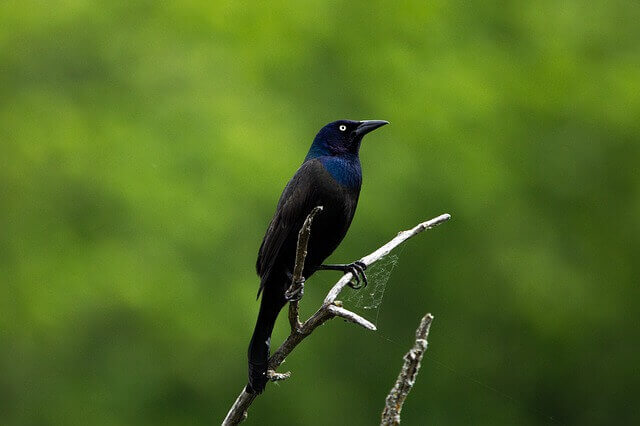
Grackles have been seen feasting on Japanese Beetles in large numbers. This is good news for gardeners and homeowners who are struggling to fight the beetles that threaten their plants. In fact, grackles feed exclusively on insects such as these. They are more effective than any pesticide, and if you see them feeding in your yard, you know it’s safe from a beetle infestation!
- Length: 11.0-13.8 in (28-35 cm)
- Weight: 2.7-5.0 oz (75-143 g)
- Wingspan: 13.8-18.1 in (35-46 cm)
- Range: North America, Central America, South America, and into southern Canada.
- Habitat: Woodlands, grasslands, wetlands, forests, and even deserts.
- Diet: Insects like beetles and caterpillars but also fruits or berries.
Common Starling
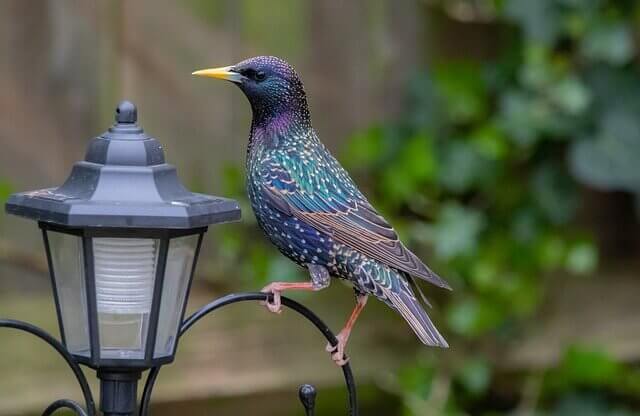
Common Starlings are the most widespread and common bird in North America. Many people think that these birds are just a nuisance, and it is good to get rid of them. However, in the past few years, many starlings have been observed feeding on Japanese beetles and larvae (grubs), and may be useful in controlling populations of this invasive species.
- Length: 8.1-9.1 in (20.5-23 cm)
- Weight: 2.1-3.4 oz (60-96 g)
- Wingspan: 11.8-15.7 in (30-40 cm)
- Range: North America, Europe, Asia, and Africa.
- Habitat: Urban habitats and agricultural fields.
- Diet: Seeds, berries some fruit and insects.
Related Posts: How To Attract European Starlings To Your Yard?
Northern Cardinal

The Northern cardinal is the North American bird species that is known for its vivid, brilliant red color. Northern Cardinals are the natural predators of Japanese Beetles. The beetles fly up to trees and other vegetation, where they are fed on by the cardinals. This helps keep down populations of these pesky insects.
- Length: 7.9-9.1 in (20-23 cm)
- Weight: 1.45-1.7 oz (41-48 g)
- Wingspan: 9.8-12.4 in (25-31.5 cm)
- Range: Eastern United States, Canada and Mexico.
- Habitat: Deciduous forests, coniferous forests, mixed woodlands, prairies, chaparral areas (shrubs), savannas (grassland with scattered trees), semi-deserts or deserts with scrubby vegetation and shrubs, and even sagebrush plains.
- Diet: Seeds, fruits, berries, insects and other small animals.
Related Posts:
- Where are Cardinal Birds Found – Best Places to Look
- Cardinal Bird Facts You Never Knew
- 10 Best Bird feeders for Cardinals
Western Meadowlark
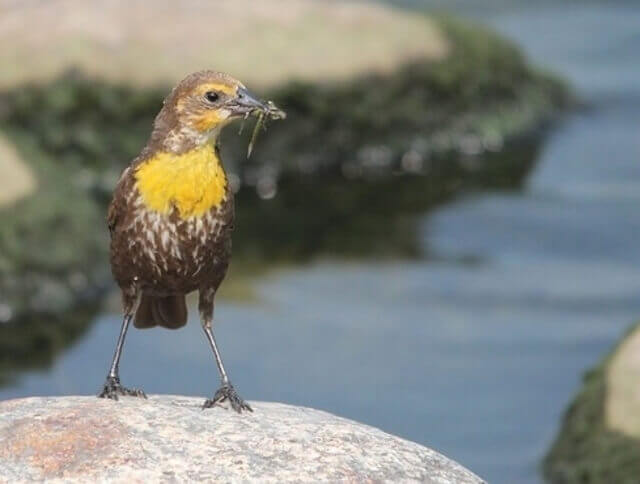
Western Meadowlarks are not only beautiful to look at, but they also eat Japanese Beetles. In order to combat this problem, meadowlarks will catch and eat these pesky insects. The best way to help your garden from becoming infested with these destructive bugs is by encouraging the presence of meadowlarks near your property.
- Length: 6.0-9.8 in (15-25 cm)
- Weight: 3.2-4.1 oz (90-116 g)
- Wingspan: 15.7-16.5 in (40-42 cm)
- Range: United States and Canada, as well as Central America.
- Habitat: Open fields, grasslands, prairies, orchards, pastures, agricultural land and roadsides.
- Diet: Insects as well as seeds and berries.
Related Post: Western Meadowlark Bird Facts
Eastern Meadowlark
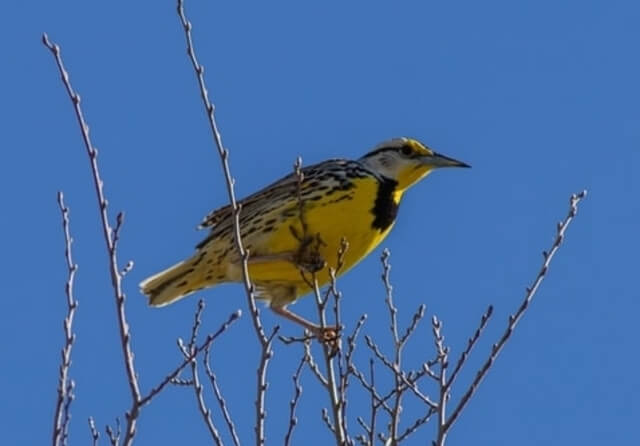
Eastern Meadowlarks feed on these beetles because they have adapted to eating their favorite food, which is vegetation and seeds from crops. The meadowlarks usually wait for the beetle to land and then attack it with their beaks, catching them in midair or picking them up off the ground after they land.
- Length: 7.1-10.4 in (18-26.5 cm)
- Weight: 3.2-5.4 oz (91-152 g)
- Wingspan: 13.4-16.1 in (34-41 cm)
- Range: Southern Canada, United States, Northern Mexico.
- Habitat: Meadows, farmland, prairies, pastures and grasslands.
- Diet: Insects, seeds, and berries.
Gray Catbird
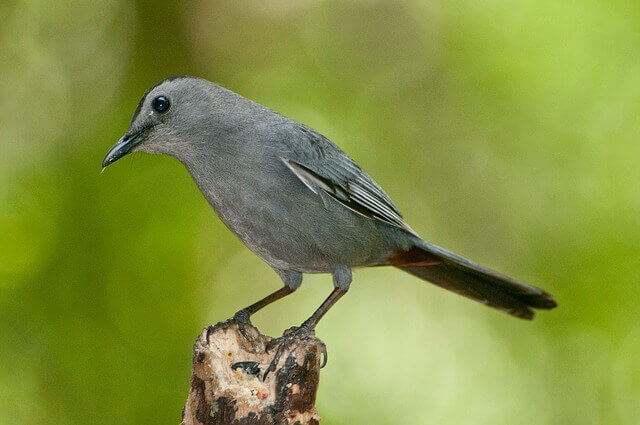
The gray catbird is a common bird in North America. Gray Catbirds eat Japanese Beetles and have been known to reduce population sizes by 50% or more during their peak season of migration (July-August). In addition to eating the beetles, they also eat insect eggs.
- Length: 8.3-9.6 in (21-24.5 cm)
- Weight: 0.8-2.0 oz (23-57 g)
- Wingspan: 8.7-12.0 in (22-30.5 cm)
- Range: Eastern United States includes southeastern Virginia, North Carolina, and central Florida.
- Habitat: Open woodlands near the edges of fields or brushy areas.
- Diet: Insects, seeds, berries and occasionally fruit.
House Sparrow
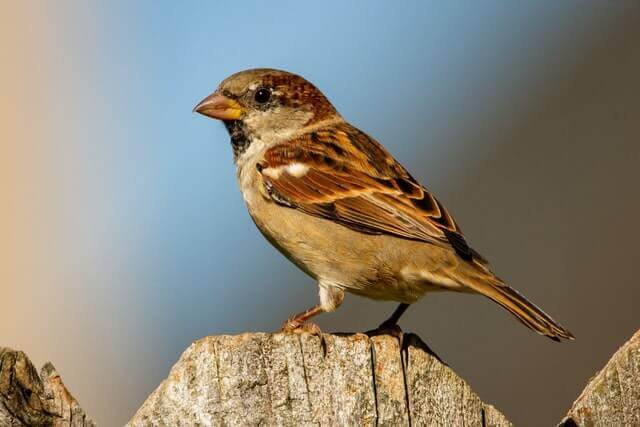
House sparrows eat Japanese beetles. They will eat a beetle and then sit on the ground to pluck out the insides of it, eating all the soft tissue before tossing away what is left. House sparrows are a great way to control the population of Japanese beetles in your yard or garden because they will eat a ton of these insects each day.
- Length: 5.7-7.1 in (14.5-18 cm)
- Weight: 0.92-1.1 oz (26-31 g)
- Wingspan: 7.9-10.0 in (20-25.5 cm)
- Range: Europe, Asia, Africa, North America and South America.
- Habitat: Open areas such as fields and parks.
- Diet: Insects, seeds, and food scraps.
Related Post: How to Attract Sparrows to your yard?
Wood Thrush
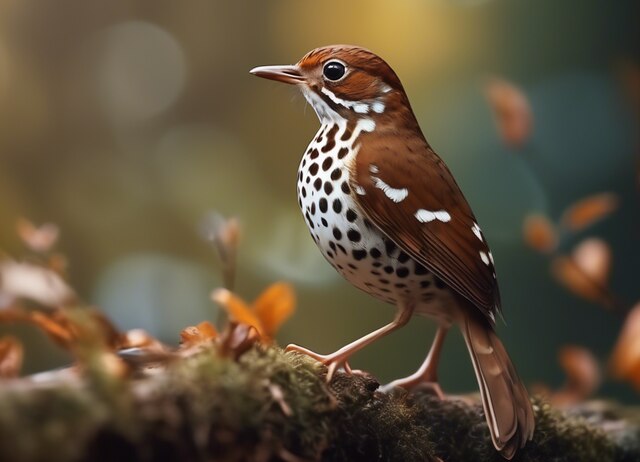
Wood Thrushes are a type of bird that can be found in North America, and their diet consists mainly of insects, including the Japanese Beetle. Wood Thrushes will travel to areas where there is high population density of beetles for an easy meal, so they could potentially help reduce pest populations.
- Length: 7.5-8.5 in (19-21.5 cm)
- Weight: 1.4-1.8 oz (40-51 g)
- Wingspan: 11.8-13.8 in (30-35 cm)
- Range: Temperate and subtropical regions of North America, Asia, Europe and Africa.
- Habitat: Temperate forests, deciduous forest edges, riparian habitats with trees and shrubs.
- Diet: Insects, earthworms, spiders, snails, frogs and other small vertebrates as well as berries and fruits.
Related Post: How to Attract Thrushes to your yard?
Brown Thrasher
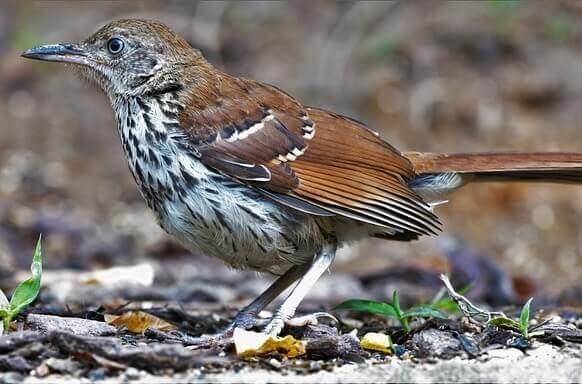
The Brown Thrasher is a songbird that is known to eat Japanese beetles. This thrasher uses its curved bill to open the beetle’s hard shell, and then it swallows the insect whole. These birds can eat a great deal of beetles in one day, which helps keep this bug population under control. The brown thrasher is also known as “the destroyer of insects” because they consume so many bugs each day.
- Length: 8.8-11.8 in (22.5-30 cm)
- Weight: 2.1-3.1 oz (60-89 g)
- Wingspan: 11.4-12.8 in (29-32.5 cm)
- Range: North America, Central America, South America, and parts of Europe.
- Habitat: Deciduous forests, suburban areas.
- Diet: Insects, seeds, berries and fruit.
Red-headed Woodpecker
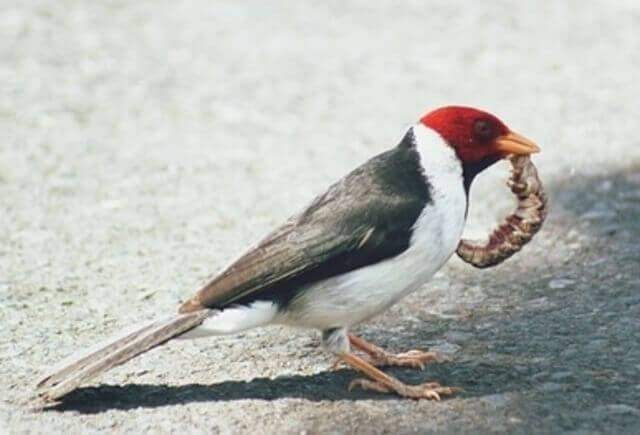
The Red-headed Woodpecker is a bird that has the best defense against Japanese Beetles. The bird eats these beetles and, when they are consumed, their stomach acid breaks down the beetle’s exoskeleton and makes it easier for digestion. Woodpeckers have been known to have eaten more than 1,000 beetles in one day!
- Length: 7.1-9.4 in (18-24 cm)
- Weight: 1.9-3.2 oz (55-92 g)
- Wingspan: 16.0-16.5 in (40.6-42 cm)
- Range: United States, Canada, Central America, South America.
- Habitat: Wetlands, forests, agricultural land, urban areas,
- Diet: Mainly insects, but they also eat seeds and berries during the winter months.
Related Post:
Blue Jay
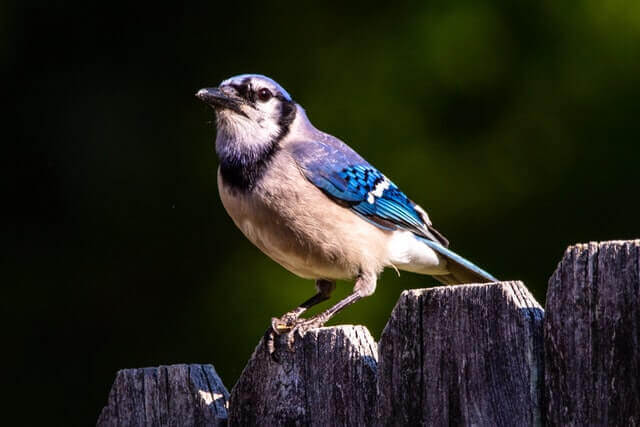
Japanese beetles are pests to farmers and gardeners, but the blue jay is their natural predator. A blue jay will typically hunt for insects in trees or on the ground by turning over leaves and digging through the soil with its strong beak. The Blue Jay can consume thousands of these bugs, eggs and larva per day!
- Length: 9.8-12.2 in (25-31 cm)
- Weight: 2.5-3.6 oz (70-101 g)
- Wingspan: 13.4-17.3 in (34-44 cm)
- Range: Eastern United States, Canada, Central America, and Northern South America.
- Habitat: Deciduous forests, coniferous forests, and residential areas.
- Diet: Seeds, fruits, insects, worms and snails.
Related Post :
- How to Attract Blue Jays to your Yard?
- Do Blue Jays Migrate? The Truth
- What do Blue Jay Eat – All The Facts
- 15 Best Bird Feeders for Blue Jays
Eastern Kingbird
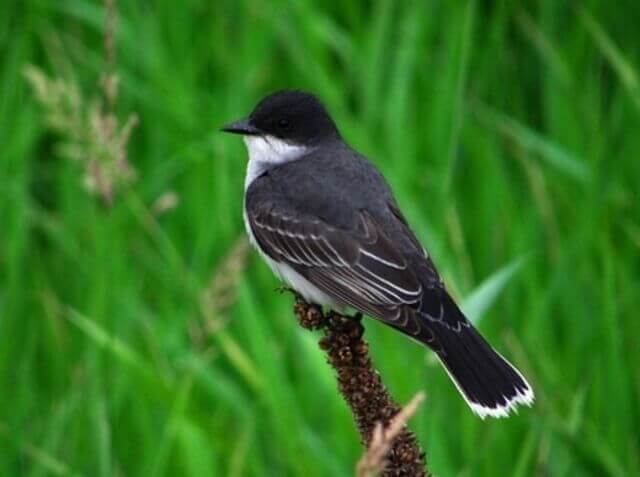
Eastern Kingbirds are the natural enemy of Japanese Beetles. They will eat any beetle they can find, and they do not discriminate between pest beetles or other harmless insects. Eastern Kingbirds have been found to reduce the number of pest beetles by 50% in some areas where they were introduced to control pests such as spruce budworm, gypsy moth, and European elm bark beetle.
- Length: 7.9-9.4 in (20-24 cm)
- Weight: 1.2-1.9 oz (32-55 g)
- Wingspan: 12.6-15.4 in (32-39 cm)
- Range: Eastern North America, Central America and South America.
- Habitat: Coastal marshes, open woodlands, mixed forests, rural and suburban areas.
- Diet: Mostly of insects, with occasional berries and fruits as well.
Scarlet Tanager
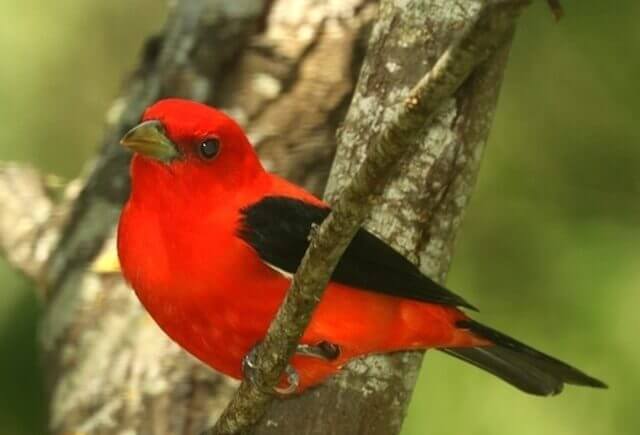
Scarlet Tanagers are a bird that lives in North America. Scarlet Tanagers feed on insects like the Japanese Beetle, so these birds help keep them under control. They also eat some beetles’ eggs before they hatch, stopping the beetle population from getting too big.
- Length: 6.0-6.9 in (15-17.5 cm)
- Weight: 0.8-1.38 oz (23-39 g)
- Wingspan: 9.8-11.8 in (25-30 cm)
- Range: Eastern United States, with some sightings in Canada and Mexico.
- Habitat: Wet forests, dry woodlands, gardens.
- Diet: Insects, berries and fruits.
Related Post: How to Attract Scarlet Tanagers to your yard?
Northern Mockingbird
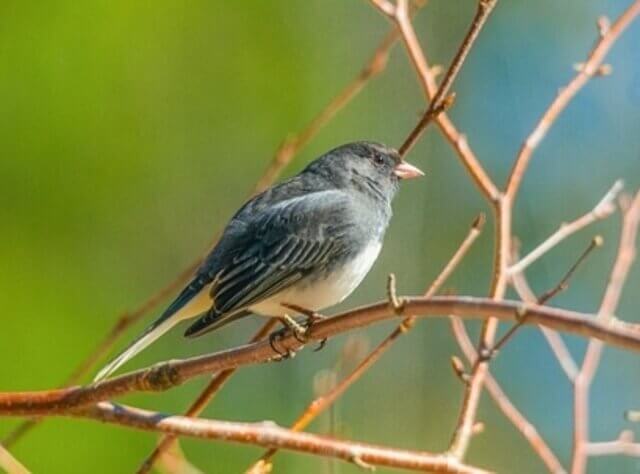
The Northern Mockingbird is a North American bird that eats insects, but typically only during its breeding season from March-July. Northern Mockingbirds feed on insects like the Japanese Beetle. This is beneficial for people with gardens, because it helps to control insect populations and lessens the damage they can do to crops.
- Length: 8.1-10.4 in (20.5-26.5 cm)
- Weight: 1.6-2.0 oz (45-59 g)
- Wingspan: 11.8-14.2 in (30-36 cm)
- Range: Eastern United States, Southern Canada, Mexico, and Central America.
- Habitat: Parks, yards, and rural areas.
- Diet: Insects, fruit and seeds.
Related Post:
- How to Attract Northern Mockingbirds to your yard?
- Birds That Look Like Mockingbirds
- 11 Birds that sound like Car alarms
American Robin
Robins are not a major predator of Japanese Beetles, but they do eat them occasionally. Robins typically hunt for beetles by searching through foliage and branches for the insects on their surfaces. The robin will then peck at the beetle to stun it before picking it up in its beak and swallowing it whole.
- Length: 8.3-11.2 in (21-28.5 cm)
- Weight: 2.8-3.0 oz (78-86 g)
- Wingspan: 11.8-15.7 in (30-40 cm)
- Range: North-eastern United States to southern Canada and south to Central America.
- Habitat: Open woodlands, suburbs, parks, agricultural fields and brushy hillsides with scattered trees.
- Diet: Mainly insects, berries and other fruit.
Related Post:
Ring-necked Pheasant
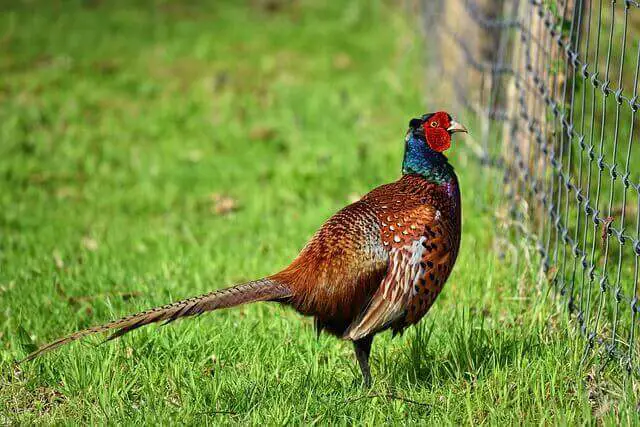
Do pheasants eat Japanese beetles? The answer is a resounding “Yes!” Pheasants are one of the few birds that will hunt and consume Japanese beetles. Pheasant farmers use this as an advantage by providing habitat for these hungry, voracious hunters to keep their fields free from pesky invaders. For those with small acreage, planting cover crops such as buckwheat or millet can also help provide an abundant food source for the ever- hungry pheasants.
- Length: 19.3-28.0 in (49-71 cm)
- Weight: 17.0-106 oz (482-3005 g)
- Wingspan: 22.7-33.5 in (55-85 cm)
- Range: North-eastern United States to southern Canada and south to Central America.
- Habitat: Open woodlands, suburbs, parks, agricultural fields and brushy hillsides with scattered trees.
- Diet: Mainly insects, berries and other fruit.
Frequently Asked Questions
What time of day are Japanese beetles most active?
Japanese beetles are often found around the garden, damaging plants and other garden produce. But when do they come out? Japanese beetles can be active during the day or night, but it is most common to see them in the morning hours between 7am-10am.
Why are Japanese beetles bad?
Japanese beetles are an invasive species of beetle that have taken over the eastern half of North America. They feed on over 300 types of plants and can cause significant damage to gardens. They pose a serious threat to natural ecosystems because they consume so many leaves, which in turn deprives native insects and animals from food sources.
What can I spray on plants to keep Japanese beetles away?
There are two ways to protect your plants from these pests: The first is using an organic pesticide such as rotenone, pyrethrum, or neem oil. These pesticides should be applied every few days and reapplied after heavy rain or watering. The second way is to use a chemical pesticide such as carbaryl (Sevin), cyfluthrin, malathion, and permethrin.
What do Japanese beetles hate?
There are many types of plants that repel Japanese beetles; some include rosemary, garlic, onion (and chives), lemongrass, catnip, lavender (and thyme), peppermint (and spearmint). I also found that Pyrethrum daisies, marigolds, and tansy work well.
Will birds eat dead Japanese beetles?
Birds will not eat dead beetles, but they will attack live ones if given the opportunity. Birds typically feed on live insects and spiders that they catch while flying around trees and other plants.
Conclusion
In conclusion, Japanese beetles can be a serious garden pest, causing significant damage to plants and crops. However, by understanding their biology and behavior, and by implementing a combination of control methods, it’s possible to manage their impact effectively.
By attracting and supporting natural predators like birds, using physical barriers, companion planting, or handpicking, gardeners can reduce Japanese beetle populations naturally and avoid the use of harmful chemicals.
It’s important to take a proactive approach to Japanese beetle management to protect your garden and promote a healthy ecosystem. By doing so, you’ll be able to enjoy a thriving garden and support the birds and other beneficial insects that help keep it that way.


